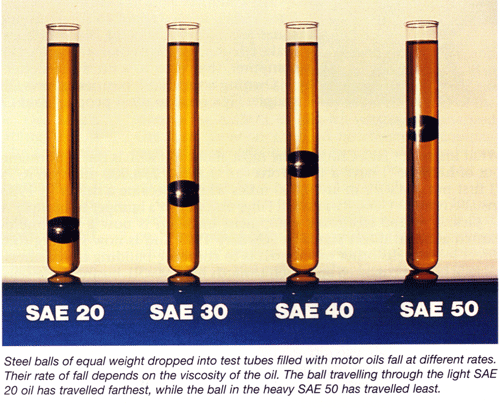Oil Viscosity
The thick and thin of engine oil viscosity.
The thick and thin of engine oil viscosity.
Viscosity is the most important of all the characteristics a lubricant may possess. The fluidity of the oil and its response to various factors determine its effectiveness in fulfilling the basic functions and requirements of a specific lubricant type.
Read more: Water and honey flow differently – that’s viscosity.
When a fluid is subjected to external forces, it resists flow due to internal molecular friction, viscosity is a measure of that internal friction. It can be referred to as the measurement of a fluid’s resistance to flow and viewed in two different ways. The first is a fluid’s tendency to flow as is visually indicated. One can think of this as the time it takes to watch a fluid pour out of a container. The term used to describe this is Kinematic Viscosity and it is expressed in units indicating flow volume over a period of time. The most commonly used unit of Kinematic Viscosity is the centistoke (cSt).

Be the first to know about our latest products, special promo codes, and new engine oil viscosities. Sign up for our AMSOIL newsletter now and take control with customizable subscriptions. Stay ahead with:
A fluid’s viscosity can also be indicated by measured resistance. You can think of this as the energy required to move an object through the fluid. It takes very little energy to stir water with a spoon. However, significantly more energy is required to stir honey with that same spoon. The term used to describe this is Apparent Viscosity, expressed in units known as centipoise (cP). Other ways to refer to a fluid’s viscosity in more common generic terms are thin, light and low, suggesting that the fluid flows readily like water. Terms such as thick, heavy, and high suggest that the fluid demonstrates a strong resistance to flow, as in the example of honey.
Viscosity is very important because it is directly related to a fluid’s load-carrying ability. The greater a fluid’s viscosity, the greater the loads that it can withstand. The fluid must be adequate enough to separate moving parts at the operating temperatures of the equipment. Knowing that a fluid’s viscosity is directly related to its ability to carry a load, one would think that the more viscous a fluid is, the better it can lubricate and protect. The fact is, the use of high viscous fluids (thick viscosity) can be just as detrimental as using oil that is too light. If you use oil with a viscosity that is too low (thin viscosity), metal-to-metal contact occurs, poor sealing occurs, and oil consumption increases. If you use too high, the fluid friction increases, resulting in reduced energy efficiency, higher operating temperatures, and hard starting – particularly at cold temperatures. The key is to select a fluid that is not too light and also not too heavy.
Fluids thicken as their temperatures decrease and thin as their temperatures increase (like candle wax). The extent to which they change is indicated by their viscosity index (VI). The index number indicates the degree of change in viscosity of an oil within a given temperature range, currently 40-100°C. Oil with a high index number, say 160, would look and behave similarly at these two temperatures. However, low index number oil, say 90, would be quite different if it became very fluid and thin and poured easily at high temperatures, much like honey, if heated to a higher than room temperature. This is why multi-grade oils exist.
A small volume of a high-quality viscosity index-improver upgrades the functionality of motor oil. High-quality motor oils contain about four to six percent viscosity index improver additives. Due to their inherently high viscosity index, synthetic oils require less than petroleum oils.
In both types of oil, the viscosity index improver allows the oil to function over a wide temperature range, and its side groups may increase fuel economy, provide dispersancy (remove sludge buildup), improve cold start-ability and reduce oil consumption. But there’s a point at which viscosity index improvers become too much of a good thing – and several lubricant manufacturers may have breached that point with their newly offered synthetics.
Viscosity index improvers, known as polymers, chemicals typified by long repeated chains of molecules, emerged from the lab in the late 1940s. Viscosity index improvers may have as many as 2000 carbon atoms in their backbone chains. Motor oil base stocks have 20 to 50 carbon atoms in their backbone chains, and the significant differences in viscosity index improvers come from their side groups that vary in chemistry or size. For example, some viscosity index improver side chains provide dispersancy while others do not.
Viscosity index improvers are subject to two critical problems due to the tangling of their long chain structure. Subject to temporary attractions between non-adjacent molecules, tangled chains thicken the oil at low temperatures and impede the oil’s cold temperature pumpability. When tangled polymer chains are subjected to a high shear rate, they are prone to rupture, a phenomenon called “shear back.” The oil that has sheared back has a permanent viscosity loss and no longer provides a thick oil film for protection in high-speed, high load or high-temperature operations. High shear rates occur in areas where the oil is forced through narrow passages in an engine, such as between the piston rings and cylinder walls.
Multi-grade oils are not equally subject to shear back or cold temperature thickening; their ability to resist these harsh environments depends on the quality of their viscosity index improver chemistry. Bargain basement oils tend to have low-quality viscosity index improvers. Superior quality oils, such as AMSOIL synthetic motor oils, are formulated with stable shear viscosity index improvers that enhance the oil’s high- and low-temperature performance.
To make 5W-50 oil, a manufacturer starts with a light viscosity base stock and adds a relatively large volume of viscosity index improver up to 15 percent. By increasing the volume of index improver manufacturers reduce the relative volume of some other components in the oil. For example with less base stock oils lose some essential lubricating properties. On the other hand, with fewer performance additives, the engine becomes more vulnerable to oxidation, start-up wear or corrosive damage.
Additionally, heavy 50 grade oils have greater internal friction than do lighter oils; hence, the engine consumes more fuel than it would if the lubricant were lighter, i.e. 30 or a 20 grade. Plus, the faster an engine runs the more power is lost to friction further compounding the inefficiency. No automobile manufacturer recommends wide-range viscosity oils, most recommend for example, 5W-20, 5W-30 or 10W-30 viscosities. Contemporary engines have extremely tight clearances, about half the clearance space of cars built just ten years ago. One size (multi-grade) oil does not fit all.
Apparently, some manufacturers believe the “one-size-fits-all” approach is to simply satisfy motorists interested in synthetics. But one size does not fit all. Race cars may need 50 weight oil, but not a 5W – unless they race in cold weather. Passenger cars often need a 5W, but not a 50 because their component tolerances are too tight for 50 weight oil. And formulating wide grade oil doesn’t just affect the viscosity, it affects the entire formulation.
The problem with the one-size-fits-all approach is that one size doesn’t fit at all. Wide grade oils don’t precisely fit the needs of any automobile and may actually cause harm. AMSOIL manufactures an extensive line of proven synthetic viscosity grades to meet the needs of every application; they are not a one size fits all motor oil.
Different vehicles with different engines and transmissions have different oil viscosity requirements.
Oil viscosity lookup for cars and trucks.
Look up oil viscosity for new and older semi-truck diesel engines.
Sir Isaac Newton gave us the basic concept of viscosity: the magnitude of the internal frictional force within a flowing liquid is equal to the product of the surface area of the liquid, the velocity gradient and a constant, called the coefficient of viscosity, which varies from liquid to liquid. Depending on their behaviour in the presence of shear, fluids are denoted as Newtonian or non-Newtonian, in honour of Sir Isaac Newton.
Jean Leonard Marie Poiseuille derived a formula for the rate of flow through a tube in terms of the tube dimensions, the pressure difference and the viscosity coefficient of the liquid. His contribution to the field is commemorated in the unit of the coefficient of viscosity, the poise.
Sir Frederick Wilfrid Scott Stokes showed that an object falling freely through a viscous liquid accelerates initially, then reaches a steady velocity known as the terminal velocity. When terminal velocity has been reached, the downward force of gravity acting on the object is exactly counteracted by the upward force of the fluid’s viscosity. The object’s terminal velocity may be used to derive the coefficient of the fluid’s viscosity. Essential to the assignment of oil viscosity, Kinematic viscosity grades are determined by timing the liquid flow rate under the influence of gravity from a capillary tube, a unit measurement known as the stoke.
Ask questions about oil viscosity and engine operations
